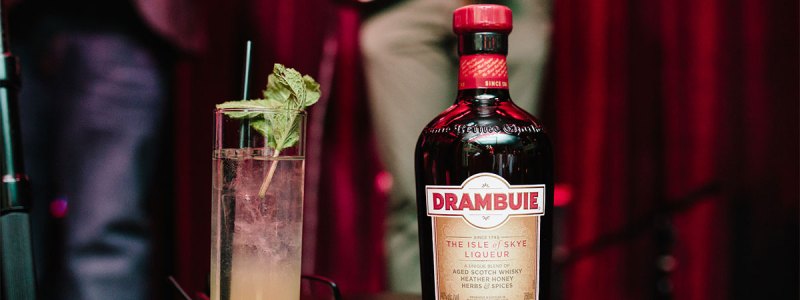
The new bottle design is meant not only to express the Isle of Skye in Scotland, where the liqueur hails from, but also the New York City jazz clubs in the 1960s where the liqueur rose to prominence as one of the key ingredients in Rusty Nails.
Drambuie was first created as Bonnie Prince Charlie’s “personal elixir,” which he first shared with one of his clansmen on the Isle of Skye as a reward for unwavering loyalty in 1746. Drambuie, which means “the drink that satisfies” in Gaelic, is made with aged Highland whisky, heather honey, herbs, and spices. The exact recipe, though, has been kept a closely-guarded secret since 1745.
According to the company, the new bottle design is “a modern interpretation of previous classic design, with stronger shoulders and a slight taper to enable it to stand proud on the shelf.” The dark brown glass and red cork closure are meant to bring to mind the jazz clubs, while the reframed logo’s colors, and Jacobite rose background evoke the liqueur’s Scottish heritage. In addition, Bonnie Prince Charlie’s name is engraved between the label and the neck.
“Drambuie has lived quite a life and we’ve been carefully planning how we honor its story to help shape its future,” said Kate Massey, Drambuie Brand Manager. “Drambuie’s look – bottle artwork and imagery, and the overall brand feel – is a nod to its past, but we were inspired by its longevity in the cocktail world. We are reconnecting with bartenders, showing them how Drambuie is capable of truly transforming a cocktail and reclaiming its place in modern cocktail culture.”
To help launch the new bottle design, Drambuie embarked on a multi-city tour to celebrate Modern Classics. Stopping in Miami, Chicago, New York, and LA, the brand invited some of each city’s top mixologists to compete in a contest for a chance to travel to Scotland to retrace the brand’s history while indulging in contemporary cocktail culture in Edinburgh.
In New York, Stefanie Bair of American Whiskey took home the crown with her two cocktails, the signature Colonel in the Kitchen and her non-whiskey drink the Extra-ordinary Beauty. So you can see the level that these bartenders are working on, we’ve included the recipes for both below. Now, all you need to do is go out, pick up a bottle of Drambuie, and get shaking.
The Colonel in the Kitchen

- 2 parts Drambuie
- 1 ½ parts heavy cream
- ½ part honey syrup
- ¼ part fresh lemon juice
- 1 barspoon dijon mustard
- 4 drops walnut oil
- 1 egg white
Method: Dry shake, wet shake. Pour into a rocks glass and top with club soda. Garnish with raw bee pollen.
Extra-ordinary Beauty

- 1 ½ parts Drambuie 15
- 1 ½ parts Hendricks
- ½ part lavender demerara syrup
- 4 drops Bittermens Xocolatl Mole bitters
- Fennel oil rinse
- 1 orange peel, expressed
Method: Rinse chilled coupe glass with fennel oil. Stir remaining ingredients together and strain into a glass. Express orange peel and garnish.
(Header photo: Amy Ellis Photography)




